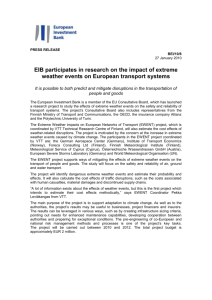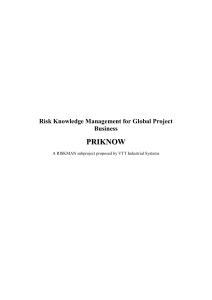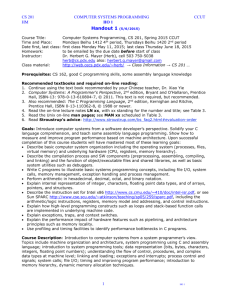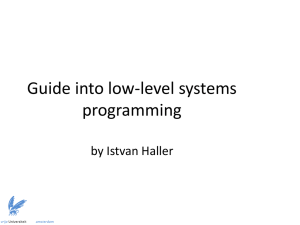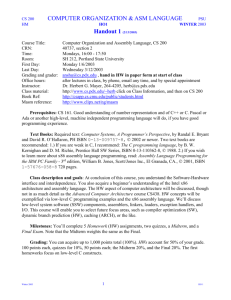Document 10749174
advertisement
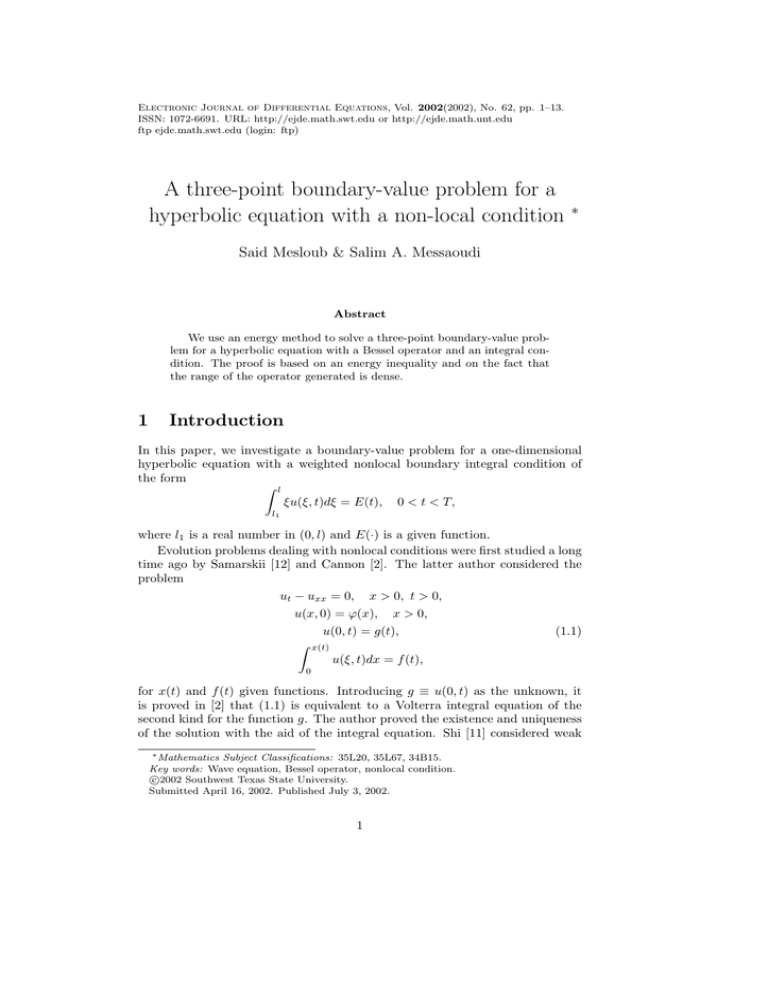
Electronic Journal of Differential Equations, Vol. 2002(2002), No. 62, pp. 1–13.
ISSN: 1072-6691. URL: http://ejde.math.swt.edu or http://ejde.math.unt.edu
ftp ejde.math.swt.edu (login: ftp)
A three-point boundary-value problem for a
hyperbolic equation with a non-local condition
∗
Said Mesloub & Salim A. Messaoudi
Abstract
We use an energy method to solve a three-point boundary-value problem for a hyperbolic equation with a Bessel operator and an integral condition. The proof is based on an energy inequality and on the fact that
the range of the operator generated is dense.
1
Introduction
In this paper, we investigate a boundary-value problem for a one-dimensional
hyperbolic equation with a weighted nonlocal boundary integral condition of
the form
Z l
ξu(ξ, t)dξ = E(t), 0 < t < T,
l1
where l1 is a real number in (0, l) and E(·) is a given function.
Evolution problems dealing with nonlocal conditions were first studied a long
time ago by Samarskii [12] and Cannon [2]. The latter author considered the
problem
ut − uxx = 0, x > 0, t > 0,
u(x, 0) = ϕ(x), x > 0,
(1.1)
u(0, t) = g(t),
Z x(t)
u(ξ, t)dx = f (t),
0
for x(t) and f (t) given functions. Introducing g ≡ u(0, t) as the unknown, it
is proved in [2] that (1.1) is equivalent to a Volterra integral equation of the
second kind for the function g. The author proved the existence and uniqueness
of the solution with the aid of the integral equation. Shi [11] considered weak
∗ Mathematics Subject Classifications: 35L20, 35L67, 34B15.
Key words: Wave equation, Bessel operator, nonlocal condition.
c
2002
Southwest Texas State University.
Submitted April 16, 2002. Published July 3, 2002.
1
2
A three-point boundary-value problem
EJDE–2002/62
solutions of the problem
ut − uxx = f + gx , (x, t) ∈ (0, 1) × (0, T ),
u(x, 0) = ϕ(x), 0 < x < 1,
ux (1, t) = 0, 0 < t < T,
Z b
u(ξ, t)dx = E(t), 0 < t < T
(1.2)
0
and discussed the well-posedness of (1.2) in a weighted fractional Sobolev space.
Along a different line, (1.2) was also considered by Ionkin [5], Makarov and
Kulyev [8], and Yurchuk [13].
In this work, we are concerned with the mixed evolution problem
1
(xux )x = F (x, t), (x, t) ∈ Q,
x
`1 u = u(x, 0) = ϕ1 (x), x ∈ (0, l),
`2 u = ut (x, 0) = ϕ2 (x), x ∈ (0, l),
ux (l, t) = E1 (t), t ∈ (0, T ),
Lu = utt −
Z
(1.3)
l
xu(x, t)dx = E2 (t),
0 ≤ l1 ≤ l, t ∈ (0, T ),
l1
where Q = (0, l) × (0, T ), with 0 < l < ∞, 0 < T < ∞, F (x, t), ϕ1 (x), ϕ2 (x),
E1 (t), and E2 (t) are known functions satisfying, for compatibility,
ϕ01 (l) = E1 (0),
Z
l
xϕ1 (x)dx = E2 (0),
l1
ϕ02 (l) = E10 (0),
Z
(1.4)
l
xϕ2 (x)dx = E20 (0).
l1
Problem (1.3), for l1 = 0, has been studied by Mesloub and Bouziani [9].
We also refer the reader to Denche and Marhoune [3] for a similar result in the
parabolic case and to Yurchuk [13], Kartynik [6] and Bouziani [1] for related
results in both parabolic and hyperbolic cases, where the Bessel operator was
replaced by (a(x, t)ux )x . It should be noted that the used method was developed first by Ladyzhenskaya [7]. Our interest lies in proving the existence and
uniqueness of a strong solution of problem (1.3). In point of view of the used
method, it is preferable to transform inhomogeneous boundary conditions to
homogeneous ones by introducing a new unknown function v defined as follows:
v(x, t) = u(x, t) − Φ(x, t),
where
Φ(x, t) = x x −
4(x − l)2 12(x − l)2
E1 (t) +
E2 (t).
l
l4
(1.5)
(1.6)
EJDE–2002/62
S. Mesloub & S. A. Messaoudi
3
Then problem (1.3) becomes
Lv = F (x, t) − LΦ = f (x, t),
`1 v = ϕ1 − `1 Φ = ϕ(x),
`2 v = ϕ2 − `2 Φ = ψ(x)
vx (l, t) = 0,
Z l
xv(x, t)dx = 0.
(1.7)
l1
The solution to (1.3) is then given by u(x, t) = v(x, t) + Φ(x, t).
We now introduce appropriate function spaces. First let
(
1 + l12 )x, if 0 < x ≤ l1
θ(x) =
x + x3 ,
if l1 ≤ x < l
and
=x v =
Z
l
v(ξ, t)dξ,
=2x v
=
x
Z lZ
x
l
v(η, t)dηdξ.
ξ
Let L2 (Q) be the space of square integrable functions with the norm
Z
2
kvkL2 (Q) =
v 2 dx dt
Q
and L2θ (Q) be the weighted L2 -space with the norm
Z
2
kvkL2 (Q) =
θ(x)v 2 dx dt.
θ
Q
1,0
We then define Wθ,2
(Q) to be the subspace of L2 (Q) with the norm
2
2
2
kvkW 1,0 (Q) = kvkL2 (Q) + kvx kL2 (Q)
θ
θ,2
θ
p
1,1
1,0
and Wθ,2
(Q) to be the subspace of Wθ,2
(Q) whose elements satisfy θ(x)vt ∈
q,p
L2 (Q). In general, a function in the space Wθ,2
(Q), with q, p nonnegative
integers, possesses x-derivatives up to qth order in L2θ (Q) and t-derivatives up
to pth order in L2θ (Q). We use also weighted subspaces on the interval (0, l)
1
such as Wθ,2
((0, l)) = Hθ1 ((0, l)), whose definition is analogous to the space on
Q. For example, Hθ1 ((0, l)) is the subspace of L2 (0, l) with the norm
2
2
2
kϕkH 1 ((0,l)) = kϕkL2 ((0,l)) + kϕx kL2 ((0,l)) .
θ
θ
θ
We associate with problem (1.7) the operator L = (L, `1 , `2 ) whose domain of
definition is D(L), the set of functions v ∈ L2 (Q) for which vt , vx , vtt , vxt , vxx ∈
L2 (Q) and satisfying conditions in (1.7). The operator L maps E into F ; E is
4
A three-point boundary-value problem
EJDE–2002/62
the Banach space of functions v ∈ L2 (Q) satisfying conditions in (1.7), with the
norm
2
2
kvkE = max kv(., τ )kW 1,1 ((0,l))
θ,2
0≤t≤T
o
n
2
2
2
= max kv(., τ )kL2 ((0,l)) + kvx (., τ )kL2 ((0,l)) + kvt (., τ )kL2 ((0,l))
0≤t≤T
θ
θ
θ
and F is the Hilbert space L2θ (Q) × Hθ1 ((0, l)) × L2θ ((0, l)), which consists of
elements F = (f, ϕ, ψ) with the norm
2
2
2
2
kFkF = kf kL2 (Q) + kϕkH 1 ((0,l)) + kψkL2 ((0,l)) .
θ
θ
(1.9)
θ
Then, we establish an energy inequality:
kvkE ≤ K kLvkF ,
∀v ∈ D(L),
(1.10)
and show that the operator L has a closure L.
Definition 1.1 A solution of the operator equation
Lv = (f, ϕ, ψ),
is called a strong solution of the problem (1.7).
Since the points of the graph of the operator L are limits of sequences of
points of the graph of L, we can extend the a priori estimate (1.9) to be applied
to strong solutions by taking limits, that is we have the inequality
kvkE ≤ K Lv F , ∀v ∈ D(L).
(1.11)
From this inequality, We deduce the uniqueness of a strong solution, if it exists,
and that the range of the operator L coincides with the closure of the range of
L.
Proposition 1.2 The operator L admits a closure.
The proof of this proposition is similar to that in [9]; therefore we omit it.
2
A priori bound
This section is devoted to the proof of the uniqueness and continuous dependence of the solution on the given data.
Theorem 2.1 For any function v ∈ D(L), we have the inequality
kvkE ≤ c kLvkF ,
where the positive constant c is independent of the function v.
(2.1)
EJDE–2002/62
S. Mesloub & S. A. Messaoudi
5
Proof We define
(
x(1 + l12 )vt
if 0 < x < l1
Mv =
3
2
2
(x + x )vt − x=x (ξvt ) + x=x (ξ vt ) if l1 < x < l .
Then we perform the scalar product in L2 (Qτ ) of equation (1.7) and M v to get
Z
Z τ Z l1
(l12 + 1)(xvx )x vt dx dt
θ(x)vt vtt dx dt −
Qτ
−
0
τ
Z
0
+
Z
0
−
Z
=
(x + 1)(xvx )x vt dx dt −
l1
τ Z l
τ
Z
2
l1
τ Z l
0
0
l
Z
Z
0
(xvx )x =2x (ξvt ) dx dt +
τ
Z
0
l
xvtt =2x (ξvt ) dx dt
l1
Z
l
xvtt =x (ξ 2 vt ) dx dt
l1
(xvx )x =x (ξ 2 vt ) dx dt
l1
Z
Z
θ(x)vt Lvdxdt −
Qτ
0
τ
Z
l
xLv=2x (ξvt ) dx dt +
Z
l1
0
τ
Z
l
xLv=x (ξ 2 vt ) dx dt.
l1
(2.2)
Integrating by parts each term of (2.2) and using conditions (1.7), we obtain
the following equations:
Z
Z
Z
1 l
1 l
2
θ(x)vt vtt dx dt =
θ(x)vt (x, τ )dx −
θ(x)ψ 2 (x, τ )dx ,
(2.3)
2 0
2 0
Qτ
−
τ
Z
Z
l1
(l12 + 1)(xvx )x vt dx dt
0
0
=
1
2
Z
−
Z
l1
(l12 + 1)xvx2 (x, τ )dx −
0
1
2
Z
l1
(l12 + 1)xϕ2x dx
(2.4)
0
τ
(l12 + 1)l1 vt (l1 , t)vx (l1 , t)dt ,
0
−
Z
0
τ
Z
l
(x2 + 1)(xvx )x vt dx dt
l1
Z
1 l 3
=
(x +
−
(x + x)ϕ2x dx
2 l1
l1
Z τZ l
Z τ
+2
x2 vx vt dx dt +
(l12 + 1)l1 vt (l1 , t)vx (l1 , t)dt ,
1
2
Z
l
3
0
−
Z
0
τ
Z
x)vx2 (x, τ )dx
l1
l
l1
xvtt =2x (ξvt ) dx dt =
(2.5)
0
1
2
Z
l
l1
(=x (ξvt (ξ, τ )))2 dx −
1
2
Z
l
(=x (ξψ))2 dx ,
l1
(2.6)
6
A three-point boundary-value problem
τ
Z
l
Z
0
(xvx )x =2x (ξvt ) dx dt
l1
τ
Z
= −l1
Z
0
Z
0
τ
Z
EJDE–2002/62
l
x2 vx (l1 , t)vt dx dt +
τ
Z
l1
l
Z
0
xvx =x (ξvt ) dx dt ,
(2.7)
l1
l
xvtt =x (ξ 2 vt ) dx dt
l1
−
l
Z
Z τZ l
1 l
(=x (ξψ))2 dx +
x3 vx vt dx dt
2 l1
l1
0
l1
Z τZ l
τ Z l
xvx =x (ξvt ) dx dt +
x2 =x (ξvt )Lv dx dt ,
(2.8)
Z
1
2
Z
= −
(=x (ξvt (ξ, τ )))2 dx +
0
l1
τ
Z
−
0
l
Z
0
l1
(xvx )x =x (ξ 2 vt ) dx dt
l1
= l1
τ
Z
0
Z
l
2
x vx (l1 , t)vt dx dt −
τ
Z
l1
l
Z
0
x3 vx vt dx dt .
(2.9)
l1
Substituting (2.3)-(2.9) in (2.2) yields
l
Z
1
2
1
+
2
Z
θ(x)ψ 2 dx +
1
2
θ(x)vt2 (x, τ )dx
0
=
l
1
2
Z
+
Z
+
Z
0
τ
0
Z
l
θ(x)vx2 (x, τ )dx
0
l
Z
θ(x)ϕ2x dx − 2
Z
0
xLv=x (ξ 2 vt ) dx dt −
l1
Z
0
θ(x)vt Lv dx dt −
Z
0
l
Qτ
τ
Z
0
τ
Z
τ
Z
l
x2 vx vt dx dt
l1
l
x2 Lv=x (ξvt ) dx dt
l1
l
xLv=2x (ξvt ) dx dt.
(2.10)
l1
Using Young’s inequality and
Z l
Z
(l − l1 )2 l
(=2x v)2 dx ≤
(=x v)2 dx,
2
l1
l1
to estimate the last five terms on the right-hand side of (2.10), we obtain the
following inequalities:
Z τZ l
Z τZ l
Z τZ l
−2
x2 vx vt dx dt ≤
xvx2 dx dt +
x3 vt2 dx dt,
(2.11)
0
Z
0
τ
l1
Z
0
l
l1
xLv=x (ξ 2 vt ) dx dt
l1
0
l1
EJDE–2002/62
(l − l1 )
2
≤
τ
Z
−
τ
Z
0
Z
0
Z
τ
l
Z
0
θ(x)vt Lv dx dt ≤
τ
l1
τ
Z
Z
0
l
xvt2 dx dt
(2.12)
l1
l1
Qτ
Z
(l − l1 )5
x(Lv) dx dt +
4
2
x2 Lv=x (ξvt ) dx dt
(l − l1 )3
2
≤
−
l
Z
7
l
Z
0
Z
S. Mesloub & S. A. Messaoudi
Z Z
(l − l1 )3 τ l 2
xvt dx dt, (2.13)
4
0
l1
Z
1
2
θ(x)vt dx dt +
θ(x)(Lv)2 dx dt,
(2.14)
2 Qτ
x(Lv)2 dx dt +
l1
1
2
Z
Qτ
l
xLv=2x (ξvt ) dx dt
l1
Z Z
l − l1 τ l
(=x (ξvt )) dx dt +
x(Lv)2 dx dt (2.15)
2
0
l1
0
l1
Z Z
Z
(l − l1 )5 τ l 2
l − l1
xvt dx dt +
θ(x)(Lv)2 dx dt.
8
2
τ
0
l1
Q
(l − l1 )3
4
≤
≤
Z
τ
Z
l
2
We also have
Z
Z
Z
Z
1 l
1
1
1 l
θ(x)v 2 (x, τ )dx ≤
θ(x)ϕ2 dx +
θ(x)v 2 dx dt +
θ(x)vt2 dx dt.
2 0
2 0
2 Qτ
2 Qτ
(2.16)
Indeed, we have
∂u2
= 2uut ,
∂t
multiplying both sides by θ(x) then integrating with respect to t from 0 to τ ,
and using Young’s inequality, we obtain
Z τ
Z τ
Z τ
θ(x)v 2 (x, τ ) − θ(x)ϕ2 (x) = 2
θ(x)vvt dt ≤
θ(x)v 2 dt +
θ(x)vt2 dt.
0
0
0
Multiplying by (1/2) and integration of both sides of this last inequality with
respect to x from 0 to l yields (2.16). Substituting (2.11)-(2.15) in (2.10) and
adding the resulting inequality with (2.16), each side, gives
1
2
Z
l
1
2
Z
θ(x)ψ 2 dx +
1
2
θ(x)vt2 (x, τ )dx +
0
≤
1
2
Z
l
Z
0
0
τ
Z
1
2
θ(x)vx2 (x, τ )dx +
0
l
l1
l
xvx2 dx dt +
Z
0
l
θ(x)ϕ2x dx +
1
2
Z
l
Z
θ(x)v 2 (x, τ )dx
0
l
θ(x)ϕ2 dx
0
3(l − l1 )5
(l − l1 )3 +
8
4
Z
0
τ
Z
l
l1
xvt2 dx dt
8
A three-point boundary-value problem
Z
Qτ
+
θ(x)vt2
dx dt +
τ
Z
0
1 (l − l1 ) +
2
2
Z
Z
l
x3 vt2
l1
1
dx dt +
2
EJDE–2002/62
Z
θ(x)v 2 dx dt
(2.17)
Qτ
θ(x)(Lv)2 dx dt
Qτ
Z
(l − l1 ) (l − l1 )3
+
x(Lv)2 dx dt.
2
2
Qτ
Rτ Rl
Rτ Rl
When we add the term 0 l1 x3 vx2 dx dt + 0 0 1 (1 + l12 )xvx2 dx dt to the righthand side of (2.17) and use the definition of θ(x), (2.17) takes the form
Z l
Z l
Z l
2
2
θ(x)vt (x, τ )dx +
θ(x)vx (x, τ )dx +
θ(x)v 2 (x, τ )dx
+
0
0
Z
l
l
Z
l
θ(x)ϕ2x dx +
θ(x)ϕ2 dx
0
0
0
Z
Z
2
+
θ(x)(Lv) dx dt +
θ(x)v 2 dx dt
Qτ
Qτ
Z
Z
2
θ(x)vx dx dt +
θ(x)vt2 dx dt ,
≤ K
θ(x)ψ 2 dx +
0
Z
Qτ
(2.18)
Qτ
5
3
1)
1)
where K = max {c1 , c2 }, c1 = max 3 + 3(l−l
+ 3(l−l
, 5 , and c2 = 1 + 2(l −
4
2
l1 ) + (l − l1 )3 . By [4, Lemma 7.1], we obtain, from inequality (2.18),
n
o
2
2
2
2
kv(x, τ )kW 1,1 ((0,l)) ≤ KeKτ kϕkH 1 ((0,l)) + kψkL2 ((0,l)) + kLvkL2 (Qτ )
θ
θ
θ
θ,2
n
o
2
2
2
≤ KeKT kϕkH 1 ((0,l)) + kψkL2 ((0,l)) + kLvkL2 (Q) .
θ
θ
θ
By taking the supremum
√ with respect to τ , over [0, T ], the energy inequality
(2.1) follows with c = KeKT /2 .
The a priori bound (1.10) leads to the following results.
Corollary 2.2 If a strong solution of the problem (1.7) exists, it is unique and
depends continuously on the data F = (f, ϕ, ψ) ∈ F .
Corollary 2.3 The range R(L) of the operator L is closed and coincides with
−1
the set R(L) and L F = L−1 F where L−1 is the continuous extension of L−1
from R(L) to R(L).
3
Existence of a solution
The main result in this paper reads as follows.
Theorem 3.1 For each f ∈ L2θ (Q), ϕ ∈ Hθ1 ((0, l)), ψ ∈ L2θ ((0, l)), there exists
−1
a unique strong solution v = L F = L−1 F of problem (1.7) satisfying the
estimate
2
2
2
2
max kv(., τ )kW 1,1 ((0,l)) ≤ c2 kf kL2 (Q) + kϕkH 1 ((0,l)) + kψkL2 ((0,l))
(3.1)
0≤t≤T
θ,2
θ
θ
θ
EJDE–2002/62
S. Mesloub & S. A. Messaoudi
9
where c is a positive constant independent of v.
Remark 3.2 According to corollary 2.3, to prove the existence of the solution
in the sense of Definition 1.1, for any (f, ϕ, ψ) ∈ F , it is sufficient to prove that
R(L)⊥ = {0}. For this purpose we need the following statement.
Proposition 3.3 Let D0 (L) = {v ∈ D(L) : `1 v = `2 v = 0}. If for all ω in
L2 (Q) and all v in D0 (L),
Z
ωLv dx dt = 0,
(3.2)
Q
then ω vanishes almost everywhere in Q.
Proof Assume that relation (3.2) holds for any function v ∈ D0 (L). Using
this fact, (3.2) can be expressed in a special form. First define the function β
by the formula
Z T
β(x, t) =
ω(x, τ ) dτ .
(3.3)
t
Let vtt be a solution of
(
xl1 vtt ,
if 0 ≤ x < l1
β= 1 2
2 (x + xl1 )vtt + x=x (ξvt ), if l1 < x < l
(3.4)
and let
(
0,
v = Rt
if 0 ≤ t ≤ s
(t − τ )vτ τ dτ, if s ≤ t ≤ T.
s
(3.5)
It follows that
(
−xl1 vttt ,
if 0 ≤ x < l1
ω=
1
2
− 2 (x + xl1 )vttt − x=x (ξvtt ), if l1 < x < l.
(3.6)
By [10, Lemma 4.2], the function v defined by the relations (3.4) and (3.5)
has derivatives with respect to t up to the third order belonging to the space
L2 (Qs ), where Qs = (0, l) × (s, T ). By replacing the function ω, given by its
representation (3.6), in (3.2) we get
−
1
−
2
Z
T
Z
s
−
Z
s
T
Z
Z
s
l
l1
T
l1
0
(l1 x + x2 )vttt
Z
1
(xvx )x dx dt
x
1
vtt − (xvx )x dx dt
x
l1 xvttt vtt −
l
l1
x=x (ξvtt ) vtt −
1
(xvx )x dx dt
x
(3.7)
=
0.
10
A three-point boundary-value problem
EJDE–2002/62
In light of conditions (1.7) and the special form of v given by relations (3.4),
(3.5), we integrate by parts each term of (3.7) to obtain the following equations:
−
T
Z
l1
Z
1
(xvx )x dx dt
(3.8)
x
0
Z l1
Z l1
Z T
1
1
2
2
l1 xvtt
(x, s)dx +
l1 xvtx
(x, T )dx −
l12 vtx (l1 , t)vtt (l1 , t)dt,
2 0
2 0
s
s
=
l1 xvttt vtt −
−
T
Z
T
Z
1
2
l
Z
1
(xvx )x dx dt
x
s
l1
Z l
Z
1
1 l
2
2
=
(l1 x + x2 )vtt
(x, s)dx +
(l1 x + x2 )vtx
(x, T )dx
4 l1
4 l1
Z T
Z Z
1 T l
+
l12 vtx (l1 , t)vtt (l1 , t)dt +
xvtx vtt dx dt,
2 s l1
s
−
l
Z
s
l1
(l1 x + x2 )vttt vtt −
1
x=x (ξvtt ) vtt − (xvx )x dx dt =
x
T
Z
Z
(3.9)
l
x2 vx vtt dx dt.
(3.10)
2
(l1 x + x2 )vtx
(x, T )dx
(3.11)
s
l1
Substituting (3.8)-(3.10) in (3.7) yields
l1
2
Z
l1
2
xvtt
(x, s)dx +
0
1
+
4
Z
l1
2
l1
Z
2
xvtx
(x, T )dx
0
l
2
(l1 x + x
2
)vtt
(x, s)dx
l1
= −
1
2
Z
T
l
Z
l
Z
s
1
+
4
xvtt vtx dx dt −
l1
Z
l1
s
T
Z
l
x2 vtt vx dx dt .
l1
Using Young’s and Poincare’s inequalities, we estimate the right-hand side of
(3.11) as follows
1
−
2
−
T
Z
s
Z
T
l
Z
l1
Z
s
1
xvtt vtx dx dt ≤
4
Z
l
2
x vtt vx dx dt
≤
l1
≤
T
Z
s
l
2
xvtx
l1
T
1
2
Z
d
2
Z
s
Z
l
x2 vx2
l1
T Z l
s
1
dx dt +
4
Combining (3.11)-(3.13), we arrive at
Z
0
l1
2
xvtt
(x, s)dx
+
Z
0
1
dx dt +
2
l1
2
xvtx
(x, T )dx
l
Z
s
2
x2 vxt
dx dt +
l1
T
Z
2
xvtt
dx dt,
(3.12)
l1
T
Z
1
2
s
Z
s
l
Z
2
x2 vtt
dx dt
l1
T
Z
l
l1
2
x2 vtt
dx dt.
(3.13)
EJDE–2002/62
+
Z
S. Mesloub & S. A. Messaoudi
l
2
(x + x
2
)vtt
(x, s)dx
l1
+
Z
11
l
2
(x + x2 )vtx
(x, T )dx
(3.14)
l1
≤ δ
Z
T
Z
s
l
T
Z
2
(x + x2 )vtt
dx dt +
l1
Z
s
l
l1
2
(x + x2 )vtx
dx dt ,
where δ = 2 max {d, 1} / min {l1 , 1}. When we add to the right-hand side of
(3.14) the quantity
Z T Z l1
Z T Z l1
2
2
δ
xvtt dx dt + δ
xvtx
dx dt,
s
0
s
0
and define the function
(
x
ρ(x) =
x + x2
if 0 < x < l1
if l1 < x < l
we deduce, from (3.14), that
Z l
Z l
2
2
ρ(x)vtt (x, s)dx +
ρ(x)vtx
(x, T )dx
0
0
Z
Z
2
2
≤ δ
ρ(x)vtt
dx dt +
ρ(x)vtx
dx dt .
Qs
(3.15)
Qs
This inequality is basic in our proof. To use it, we introduce the new function
Z T
η(x, t) =
vτ τ dτ.
t
Then
vt (x, t) = η(x, s) − η(x, t),
vt (x, T ) = η(x, s).
Thus inequality (3.15) becomes
Z l
Z l
2
ρ(x)vtt (x, s)dx + (1 − 2δ(T − s))
ρ(x)ηx2 (x, s)dx
0
0
≤ 2δ
T
nZ
l
Z
s
2
ρ(x)vtt
dx dt +
T
Z
0
l
Z
s
0
o
ρ(x)ηx2 (x, t) dx dt .
(3.16)
Hence, when s0 > 0 satisfies T − s0 = 1/4δ, (3.16) implies
Z l
Z l
2
ρ(x)vtt
(x, s)dx +
ρ(x)ηx2 (x, s)dx
0
0
≤ 4δ
nZ
T
Z
s
l
2
ρ(x)vtt
dx dt +
Z
0
0
s
T
l
Z
s
for all s ∈ [T − s0 , T ]. If, in (3.17) we put
Z
Z TZ l
2
ρ(x)vtt dx dt +
g(s) =
s
T
ρ(x)ηx2 (x, t) dx dt
0
Z
0
l
ρ(x)ηx2 (x, t) dx dt,
o
(3.17)
12
A three-point boundary-value problem
then we have
−dg
ds
EJDE–2002/62
≤ 4δg(s), from which it follows that
−d
(g(s) exp(4δs)) ≤ 0.
ds
Integrating this equation over (s, T ) and taking in account that g(T ) = 0, we
obtain
g(s) exp(4δs) ≤ 0.
This inequality guarantees that g(s) = 0 for all s ∈ [T − s0 , T ], which implies
that vtt = 0 on Qs where s ∈ [T − s0 , T ]. Hence it follows, from (3.6), that
ω ≡ 0 almost everywhere on QT −s0 . Proceeding this way step by step along
the rectangle with side s0 , we prove that ω ≡ 0 almost everywhere on Q. This
completes the proof of the Proposition 3.3.
Proof of Theorem 3.1
Suppose that for some W = (ω, ω1 , ω2 ) ∈ R(L)⊥ ,
(Lv, ω)L2θ (Q) + (`1 v, ω1 )Hθ1 ((0,l)) + (`2 v, ω2 )L2θ ((0,l)) = 0.
(3.18)
Then we must prove that W ≡ 0. Putting v ∈ D0 (L) into (3.18), we have
(Lv, ω)L2θ (Q) = 0.
Hence Proposition 3.3 implies that ω ≡ 0. Thus (3.18) takes the form
(`1 v, ω1 )Hθ1 ((0,l)) + (`2 v, ω2 )L2θ ((0,l)) = 0,
∀v ∈ D(L).
(3.19)
Since the quantities `1 v and `2 v can vanish independently and the ranges of
the trace operators `1 and `2 are dense in the spaces Hθ1 ((0, l)) and L2θ ((0, l))
respectively, the equation (3.19) implies that ω1 ≡ 0, ω2 ≡ 0. Hence W ≡ 0.
The proof of Theorem 3.1 is established.
Acknowledgment This work was completed while the first author was visiting the Mathematical Sciences Department at KFUPM. Both authors would
like to thank KFUPM for its support.
References
[1] A. Bouziani, Solution forte d’un problème mixte avec condition intégrale
pour une classe d’équations hyperboliques, Bull. CL. Sci., Acad. Roy. Belg.
8 (1997), 53 - 70.
[2] J. R. Cannon, The solution of heat equation subject to the specification of
energy, Quart. Appl. Math. 21 (1963), 155 - 160.
[3] M. Denche and A. L. Marhoune, A Three-point boundary value problem
with an integral condition for parabolic equations with the Bessel operator,
Appl. Math. Letters 13 (2000), 85 - 89.
EJDE–2002/62
S. Mesloub & S. A. Messaoudi
13
[4] L. Garding, Cauchy’s problem for hyperbolic equations, University of
Chicago, 1957.
[5] N. I. Ionkin, Solution of a boundary value problem in heat conduction with
a nonclassical boundary condition, Differential Equations 13 (1977), 294 304.
[6] A. V. Kartynnik, Three-point boundary value problem with an integral
space-variable condition for a second order parabolic equation, Differential
Equations 26 (1990), 1160 - 1162.
[7] O. A. Ladyzhenskaya, Boundary-value problems for partial differential
equations, Dokladi Academii nauk SSSR 97 n.3 (1954).
[8] V. L. Makarov and D. T. Kulyev, Solution of a boundary value problem for
a quasi-parabolic equation with a nonclassical boundary condition, Differential Equations 21 (1985), 296 - 305.
[9] S. Mesloub and A. Bouziani, On a class of singular hyperbolic equation
with a weighted integral condition, Internat. J. Math. & Math. Sci. 22 No.
3 (1999), 511 - 519.
[10] S. Mesloub, On a nonlocal problem for a pluriparabolic equation, Acta Sci.
Math. (Szeged) 67 (2001), 203 - 219.
[11] P. Shi, Weak solution to an evolution problem with a nonlocal constraint,
SIAM J. Math. Anal. 24 No. 1 (1993), 46 - 58.
[12] A. A. Samarskii, Some problems in differential equations theory, Differentsial’nye Uravnenya 16 No. 11 (1980), 1221 - 1228.
[13] N. I. Yurchuk, Mixed problem with an integral condition for certain parabolic
equations, Differential equations 22 No. 12 (1986), 1457 - 1463.
Said Mesloub
Department of Mathematics, University of Tebessa, Tebessa 12002, Algeria
e-mail : mesloubs@yahoo.com
Salim A. Messaoudi
Department of Mathematical Sciences, KFUPM, Dhahran 31261
Saudi Arabia
e-mail : messaoud@kfupm.edu.sa
